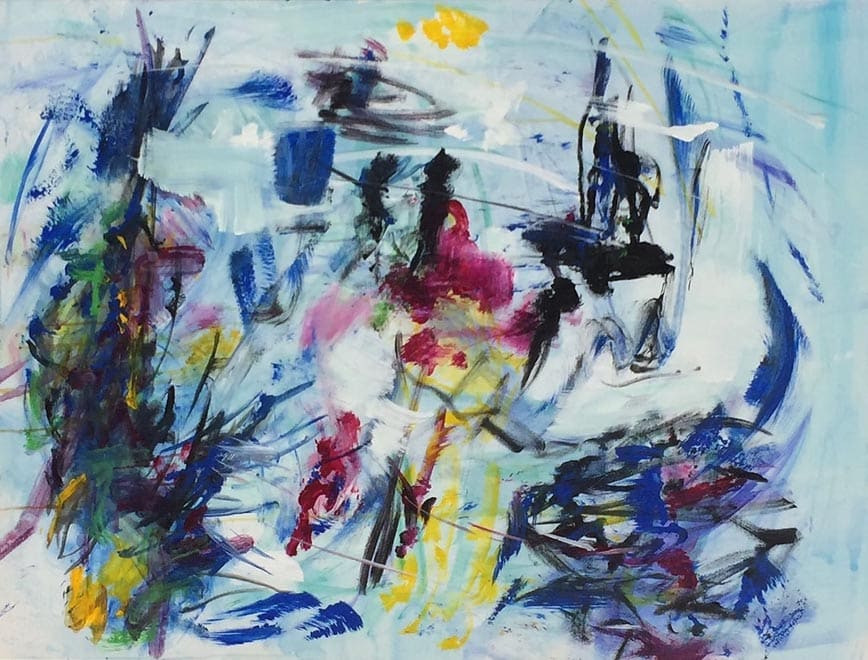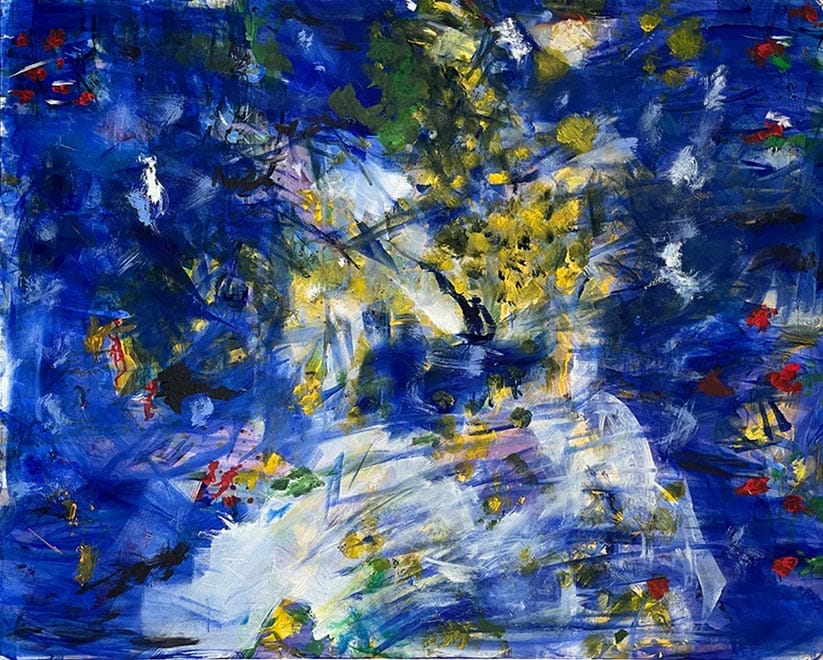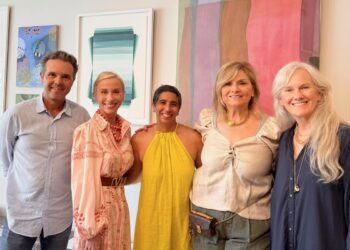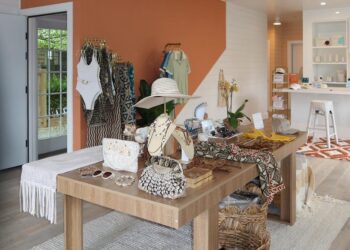 Bonnie Zindel’s latest Hamptons showing has made an impression. Since opening this summer at Water Mill’s Windmill Art Gallery, Zindel’s exhibition has been featured in the East Hampton Star and well-attended by the robust Hamptons art scene.
Bonnie Zindel’s latest Hamptons showing has made an impression. Since opening this summer at Water Mill’s Windmill Art Gallery, Zindel’s exhibition has been featured in the East Hampton Star and well-attended by the robust Hamptons art scene.
Zindel is a trained psychoanalyst who paints from the creative unconscious, making it visible. As a doorway to our originality, the creative unconscious can surface when we least expect it, translating everyday chaos, long-forgotten memories, and feelings from our bodies into poetry, stories, paintings, and music.
Her contribution to the arts is pronounced and multimodal. Over the course of a decade, she founded the Creative Salon at the National Institute of Psychotherapies. The salons made room for creative expression in the psychoanalytic community through poems, stories, music, and film while also celebrating the joy of creativity in all of us.
Zindel’s work is vivid and evocative. She is as expressive in words as in paint, and I was taken aback by how eloquently she spoke about the pivotal role the Hamptons have played in shaping and influencing her work as a painter. In her own words, Bonnie Zindel shared with us the pivotal role the Hamptons have played in shaping her work.
How has your background in psychoanalysis influenced your approach to painting and your interpretation of the creative unconscious?
Being a psychoanalyst has allowed me to delve deeper into my interior world and tap into my creative unconscious. It’s rather elusive and cannot be commanded; I have to be ready to listen. I have written plays and novels, which have brought me to that place where creativity strikes like a thunderbolt. For 25 years, I have run writing groups that have allowed me to help others find that same creative space. Now, as a painter, I use color and light to reach that place. My creative impulses guide me. Painting on an easel felt limiting, so I take large canvases outside and paint on the ground, sometimes on my hands and knees. I love feeling the grass and earth beneath me, and smelling the fresh air while I work.
You mentioned discovering a new creative process at the Art Barge in Amagansett. Can you describe how that setting and experience shaped your work?
I studied painting at the Art Barge with artist George Negroponte, who suggested I paint on a larger canvas. I brought a big canvas out onto the deck and, using ultramarine blues, cadmium yellow, crimson, and magenta, I mixed the colors. With rags, I rubbed, blended, and wiped away paint to expose the layers beneath. Sometimes, I let paint drip down the canvas. If I leaned the canvas against a tree, I would try to capture the shadows as they moved across the surface.
The Art Barge provided an atmosphere that sparked imagination with every breath. People standing at their easels were deeply engrossed, and one could feel creativity filling the room. The bay in Amagansett is calm, with a blue sky above and shifting clouds pulling me outside. The scent of the sea permeates my being, and the clear light inspires me, transforming my work.
The Hamptons’ light and landscape have inspired many artists. How does the environment here impact your art, both visually and emotionally?
The Hamptons light has inspired many great artists—de Kooning, Jackson Pollock, and Lee Krasner—because the light here is golden and beautiful. The landscape is exquisite, with beaches, farms, and lush greenery bursting with color. It’s not just the light; it’s the entire environment. You’re painting in this exquisite place, hearing the birds chirping, crickets buzzing, and the honking of geese flying in V-formation. At 5:30 p.m., peace and serenity settle in, and it’s that deep connection with nature that allows me to access my interior world.
Your work often explores themes of memory and the unconscious. Are there any specific memories or personal experiences that have significantly influenced your recent pieces?

My work as a psychoanalyst has deeply affected my painting. I’m very attuned to picking up the feelings of others and how they influence my own emotions. The unconscious is the truest part of ourselves—home to our originality and creativity. When you paint from the intellect, it creates a different result. When I paint from that unconscious place, the painting guides me. It feels like a surprise every time as if the work surrenders itself to me. We make significant life decisions from the unconscious, often without realizing it—who we marry, the work we do. The unconscious reveals itself through dreams, and painting is a perfect manifestation of that dream-like state because it comes unbidden. We dream our paintings and paint our dreams. I’ve also taught contemporary dreams to psychoanalysts in training at my institute, which has shaped my understanding of this connection.
You’ve played a role in fostering creativity within the psychoanalytic community through your Creative Salon and your work as the Creative Literary Editor of Psychoanalytic Perspectives. How has this multidisciplinary experience influenced your artistic journey?
I’ve been a writer for most of my life, and I started the Creative Literary section of Psychoanalytic Perspectives, a scholarly journal. My goal was to create space for the creative life. I would send out calls with themes like “Love” or “Mothers,” and ask people to write about their experiences. The response was overwhelming, and I often had to create two issues—one for poetry, the other for narratives. The submissions came from people all over the world. After many years as the Creative Editor, I didn’t want these beautiful works to be lost, so I secured a contract with Karnac Books in London, and later published Writing on the Moon: Writing from the Creative Unconscious.
Wanting to tap into the creative lives of psychoanalysts, I started a Creative Salon, modeled after Café Figaro, where we would present themes like comedy, music, or the creative process to an audience. During the pandemic, when we were all in lockdown, I called for poetry and stories from people across the globe. We held an evening over Zoom, where people from places like France, India, Australia, and London—some waking at 2 a.m.—came together to share their feelings of isolation during the pandemic. Over 400 people attended, and it was deeply moving.
How do you balance the expressive, often spontaneous nature of your art with the analytical framework of your psychoanalytic background?
As therapists, we use imagination to step into the patient’s experience, walking in their shoes. The best moments in therapy often come without words, much like the way art expresses what cannot be spoken. When I was young, I danced as a form of expression, and painting now feels similar. When I’m working on a canvas, it’s like a dance—I’m moving continuously, expressing deep emotions through color and motion.
What message or feeling do you hope visitors to your exhibition at the Windmill Art Gallery take away from your work?

Having my exhibition at the Windmill Art Gallery was thrilling. To see my paintings displayed in one room, to open up my private world and share it with others, was both daunting and vulnerable. As people came in, they engaged with the work, and I think they connected to it. Painting is private, but once it’s shared, the viewer must bring their own experience to it. It’s like meeting halfway—I put so much of myself into the painting, and then I let it go, hoping the viewer will bring their own 50% to the experience.






